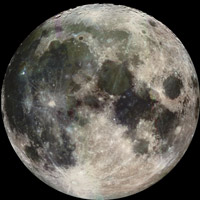She chose five from a selection of 70 proposals submitted to her and added two of her own to them - one of them being the launch of the LRO spacecraft in 2008

Photo: The moon, as photographed from the Galileo spacecraft on its way to Jupiter
Credit: USGS
NASA is preparing for the new missions on the moon.
NASA has selected the new proposals for the next space exploration missions. The proposals and plans are part of NASA's effort to develop new opportunities to lead important scientific research, and new programs for lunar exploration. From a selection of 70 proposals, NASA chose seven, of which two programs were developed: advanced science for discoveries and research on the moon, and the launch of the multi-mission spacecraft LRO (Lunar Reconnaissance Orbiter).
The missions are designed to help scientists understand the dust on the moon's surface that causes problems for astronauts on the mission. Other studies will provide new insights into the interior of the moon, search for natural sources, and use a laser device that will gather more precise information about the location and nature of the moon.
The two missions brought from NASA's Jet Propulsion Laboratory (JPL) in Pasadena, California are:
1. A package of geophysical experiments on the moon. (Autonomous Lunar Geophysical Experiment Package)
2. The electronic device that receives and transmits signals (transponder) and the device that receives light (retroreflector) operated by a laser. (Lunar Laser Transponder and Retroreflector Science).
The other tasks received:
1. At the NASA space research center in Maryland (Goddard Space Flight Center, Greenbelt, Md) - the analysis of the volatile substances by pyrolysis (chemical decomposition by heat) of regolith (a powdery layer of rock fragments that covers the bedrock layer) on the moon using a mass spectrometer.
2. At the NASA Space Research Center in Maryland, equipment will be developed for seismological measurement and heat conduction on the moon that will warn of dangers.
3. At the research institute in Boulder, Colorado (Southwest Research Institute, Boulder, Colo.) - they will study the environmental radiation and the roglit.
4. At the US Army Engineer Research and Development Center in Fort Wainwright, Alaska (US Army Engineer Research and Development Center, Fort Wainwright, Alaska) - a "scientific suitcase for lunar research" will be developed: a kit for characterizing the regolith.
5. Ball Aerospace and Technologies Corp., Boulder, Colo. - development of a tracking facility for the dust on the moon.
The much information expected to be obtained by the plans and proposals submitted will expand our knowledge about the life of the moon. In addition, the future plans will provide data for proper management and the creation of living and working conditions for the researchers who will stay there. The studies will include simulations and laboratory experiments to better understand the environment and the dangers inherent in it such as dust and radiation. The program will support analyzes and data provided by previous missions such as the Apollo spacecraft and robotic missions, which were done in the past to better understand the moon's development process.
The lunar reconnaissance satellite LRO (Lunar Reconnaissance Orbiter) is planned for launch at the end of 2008, it will circle the moon for at least a year and provide information that will accelerate new developments for scientific missions in the future.
Translation: Yariv Zerbiv
Source: NASA's Jet Propulsion Laboratory.

2 תגובות
What if samples of isotopic fuel that the moon is regularly bombarded with? {Helium 3}
No microbial research? It seems that the main thing they miss...